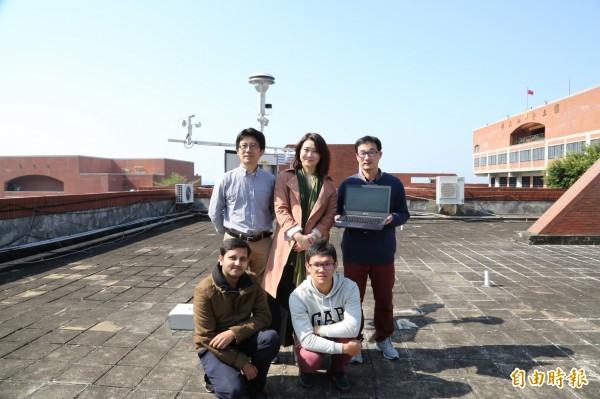
NSYSU set up Monitor for PM2.5
Recently, the concentration of fine suspended particulates (PM2.5) in the atmosphere in the south, especially in the area, has been high. Even the 85th building, the highest landmark in Kaohsiung, seemed to disappear due to haze. In order to accurately monitor the PM2.5 concentration in the surrounding area of the seaport to protect the health of the people of the country, National Sun Yat-sen University has set up the country's first real-time automatic PM2.5 monitoring facility closest to the seaport in the campus, and the measured value every hour is displayed. Real-time air quality signs are set up on the campus, at the entrance of the Xiziwan tunnel and at the school gate to alert the public, teachers and students, and tourists in the Xiziwan Scenic Area, and take measures such as protection and allergy prevention.
Associate Professor Chia C. Wang, the Director of the Aerosol Science Research Center at National Sun Yat-sen University, pointed out that this newly installed PM2.5 real-time automatic monitor is currently the closest PM2.5 monitoring facility in the country to the seaport area. According to the values measured in the past two months from November 106 to January 107, it is found that although the overall trend of PM2.5 concentration changes in the harbor area is consistent with that of neighboring stations, due to the topography of Chai Mountain, the overall average , The concentration of PM2.5 at the seaside is slightly lower than that of nearby stations (Qianjin and Zuoying stations). However, during certain periods, the PM2.5 concentration at the harbour was higher than that in other cities, indicating that some environmental factors or human activities may have a significant impact on the regional PM2.5 mass concentration during a specific period. At present, the team of Aerosol Science Research Center of Sun Yat-sen University will also analyze and discuss the chemical composition of PM2.5 in the seaport area to find out countermeasures.
The PM2.5 real-time automatic monitoring facility at Sun Yat-Sen University uses the internationally accepted "beta-ray attenuation method" to monitor. Associate Professor Chia C. Wang, the Director of the Aerosol Science Research Center at National Sun Yat-sen University said that the higher the PM2.5 concentration, the more severe the attenuation measured by the beta-ray detector, and vice versa. The same is true; currently, it provides real-time updated PM2.5 mass concentration data every hour to remind people to take care of their own health. The research team also carried out a systematic analysis and comparison of the PM2.5 value obtained with the PM2.5 value measured by other representative PM2.5 measurement stations in Kaohsiung City to clarify the PM2 in the surrounding area of the seaport. The difference in the nature and source of PM2.5 from the metropolitan area, and the factors that may cause these differences, such as geographic location, topography and meteorological conditions, human activities, etc.
The main sources of PM2.5 include two categories: stationary pollution sources and mobile pollution sources. Associate Professor Chia C. Wang, the Director of the Aerosol Science Research Center at National Sun Yat-sen University further explained that although exhaust emissions from land-based transportation vehicles (steam, locomotive, and diesel vehicles) are the main source of mobile PM2.5 pollution, mobile sources of PM2.5 other than land include ships (sea) and aircraft (air). The possible impact on the environment and health cannot be ignored either. Since most ships and freighters use heavy fuel oil left over after the extraction of gasoline and diesel, it not only has the characteristics of high molecular weight and high viscosity, the original PM2.5 emitted by the tail gas, and the derivative PM2 formed by the chemical reaction of gaseous precursors may be higher in concentration and more harmful to the human body.
Associate Professor Chia C. Wang, the Director of the Aerosol Science Research Center at National Sun Yat-sen University said that she hoped to show or analyze PM2.5 related data and components in real time, care for the local environment and the public, and fulfill the social responsibility of the University. On the one hand, she hoped that the public would be alert to PM2.5 in the surrounding environment, so as to take timely protective measures; on the other hand, she hoped that through academic research, she could have a deeper understanding of PM2.5 pollution sources in the port area and metropolitan area in order to find out the way to deal with it.
Related reports:
- 【台灣新生報】環保局與高雄港締盟 抗空污
- 【聯合新聞網】中山大學即時把關空污 西子灣設PM2.5監測儀
- 【中時電子報】港區抗汙 中山大學設PM2.5監測設施
- 【中華日報】中山大學設PM2.5即時自動監測儀
- 【自由電子報】空污嚴重 中山大學首設全國最近海PM2.5測站
- 【大紀元】防空汙 全國首創小型掃街車上路
- 【天眼日報】中山大學即時把關空污 西子灣設PM2.5監測儀
- 【大成報】中山大學即時把關空污 西子灣設PM2.5監測儀
- 【鮮週報】中山大學首設臨海PM2.5監測設施 及時顯示提醒師生民眾留意
- 【自由時報】〈南部〉空污嚴重西子灣旁設PM2.5測站
- 【中天快點TV】港區抗汙 中山大學自動監測
- 【台灣數位新聞網】中山大學設置全國最接近海港的PM2.5即時自動監測設施 隨即提醒民眾、師生及遊客
- 【台灣時報】防制空污中山大設PM2.5監測設施






